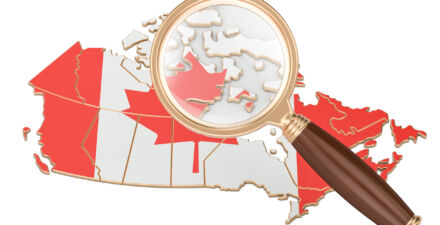Overview
Equitable Growth in Conversation is a recurring series where we talk with economists and other academics to help us better understand whether and how economic inequality affects economic growth and stability. In this installment, Austin Clemens, senior fellow at the Washington Center for Equitable Growth, speaks with Miles Corak, an economist at The Graduate Center at the City University of New York and a senior scholar at the Stone Center on Socioeconomic Inequality. In their conversation, Clemens and Corak discuss:
- The development of the Great Gatsby Curve
- The public policy implications of the Great Gatsby Curve
- Correlation and causation in economic inequality and intergenerational mobility
- Inequality and mobility comparisons between Canada and the United States
- Perceptions of the American Dream in the United States and Canada
- The global Great Gatsby Curve and the evidence and the perceptions of its causes and consequences
Austin Clemens: Thanks for sitting down with us for this conversation about your research and its implications for policymakers.
Miles Corak: I’m delighted to do so.
The development of the Great Gatsby Curve
Clemens: I want to start with a general overview of your research. Most notably, you’re one of the progenitors of the Great Gatsby Curve, which shows that there’s a correlation between higher economic inequality and lower social mobility among the 38 developed member-nations of the Organisation for Economic Co-operation and Development. What principles and questions guide your research agenda? How were you led to that work?
Corak: I have a number of origin stories that brought me to the study of social mobility and its relationship to economic inequality. First off, I began this research agenda in the early- to mid-1990s. At that time, the Convention on the Rights of the Child had been put forward by the United Nations and ratified by many countries, and child poverty was moving up the public policy agenda. In my country, Canada, where I was living at the time, there was even a resolution to end child poverty by the year 2000.
A lot of the motivation for that agenda, or at least the way it was framed in public policy discussions, was to invest in children, promoting not just their immediate well-being but also their capabilities and capacities when they reach adulthood. And to sell this political agenda, there were a whole series of metaphors employed in the effort, but they all basically explained that if we can keep little Johnny out of poverty, then he will grow up to be a more engaged citizen, less prone to criminality, among a lot of other social benefits.
Importantly, there was a lot of work being done then in the neurosciences about brain development and the long-term consequences of a stressful life in children’s early years due to various dimensions of poverty. Yet in spite of the framing of this discussion to encourage governments to invest in social infrastructure to reduce child poverty, there wasn’t any real evidence in many countries about the long-term relationship between children’s origins and their outcomes over the course of their lives. So, that was the policy agenda that began motivating my work, but it only really took place because of other developments in economics.
Principally, there was very important work done by Gary Solon. Solon, who, at the time, was at the University of Michigan and is now a professor emeritus there, wrote an influential paper published as a lead article in the American Economic Review in the early 1990s, using the university’s Panel Study of Income Dynamics, with the number of observations at the time being measured in just the hundreds—no more than 300. But Solon understood that when measuring intergenerational mobility, or the degree of stickiness of incomes between parents and their children, there are important measurement errors and important issues having to do with the quality of data that led to an understatement of that stickiness.
This had led academics working in this field to have a statistically biased misunderstanding of how fluid the socioeconomic class structure was in the United States. Solon’s paper was a watershed because he corrected for these biases using the best data available to him at the time. He doubled the estimate of what economists call intergenerational income elasticity—basically, a measure of the degree of stickiness between parent and child incomes, in percentage terms. This led to our perception and our understanding in the social sciences of the United States being rather sticky in terms of intergenerational mobility instead of the very fluid country we had previously imagined—a nation where almost 50 percent of parental advantage is passed on to children, as opposed to something like 20 percent, which is what we imagined before Solon’s contribution.
The other thing happening at this time was the major revolution of globalization, beginning in the 1980s but really picking up force in the 1990s. Globalization rapidly meshed with the increasing capabilities of the computer, which significantly changed our workplaces and led to rising economic inequality. So, I did research on Canada motivated by Solon’s work, and then for other countries. European researchers were also paying attention to Solon’s work, and they found innovative ways to use data to create further estimates. As the years rolled by, as we moved into the late 1990s and early 2000s, there began to be a roughly comparable set of national estimates that could be used.
Now, the other important thing that Solon did was some theoretical work that he presented at a conference I organized in the early 2000s, in spite of him being mostly an empirical economist. It was a rather intimate gathering, but it led to a book. His contribution to that book made a telling prediction based on his rethinking of a famous theoretical model of intergenerational mobility developed by the [late Nobel laureate] Gary Becker at the University of Chicago and his co-author Nigel Tomes [then at the University of Western Ontario].
Solon made the prediction that, as inequality went up, intergenerational mobility went down.
So, by the 2000s, we in the community of social sciences had not only the data and empirical estimates, but also a new theoretical frame to suggest that countries that were more unequal at a point in time were also less generationally mobile over time. That inequality of outcomes causally influenced the degree of mobility intergenerationally. All the elements of the Great Gatsby Curve were there, and Gary Solon, in some sense, I think of as the grandfather of the Great Gatsby Curve.
I then put together estimates for as many countries as I could by ranking countries. I rank countries in two ways: according to the degree of inequality of outcomes and then according to the degree of social mobility. And that curve or that line or that scatter plot of countries drifts in a positive direction in the sense that higher inequality is related to lower mobility.
Other social scientists were thinking this way as well, people such as Markus Jäntti and Anders Björklund at Stockholm University and Jo Blanden at the University of Surry in the United Kingdom. And we could all see why this was important for public policy conversations—particularly in the United States, a country that historically has higher inequality than many of its counterparts in the OECD.
The public policy implications of the Great Gatsby Curve
Clemens: How have those evidence-driven findings played out in policymaking?
Corak: Well, the framing of public discourse prior to the development of the Great Gatsby Curve, in some sense, always justified that higher inequality because Americans thought of themselves as more mobile. Yes, there’s higher inequality, the thinking went, but Americans can expect either in their lifetimes or certainly in the adult lifetimes of their children to move up the economic ladder, reaping the fruits of hard work, energy, and talent as they climb that ladder.
The so-called American Dream.
The fact that the United States had higher inequality and less mobility cast a very different light on that metaphor. And yet it also was necessary for other things to come together for the reality of the Great Gatsby Curve to truly resonate. After all, public policy is certainly made by ideas, but it’s also made by interest groups and political parties and the ideologies they bring.
It was upon the election of President [Barack] Obama that these three rivers of influence came together to put inequality on the public policy agenda. And one of the economists that President Obama brought into the White House was the late Alan Krueger of Princeton University, who, if not an active researcher in the social mobility area, was certainly well-read and interested in this field. I had several conversations with him before and just after he joined the White House, drawing his attention to this relationship. And I remember sending him an email saying that if he ever was interested in a graph like this, I had the data.
Clemens: And he was.
Corak: Indeed, he was. In a 2012 speech at the Center for American Progress in Washington, Krueger labeled that relationship the Great Gatsby Curve. And it helped inform the thinking of the administration.
It continues to be important, of course, not just as a communication device or metaphor, but also because it raises important research questions that I and others are still dealing with. To piece together some of those questions, the Great Gatsby Curve asks us to think about what exactly is it we care about? What type of social mobility do we care about? And a public policy conversation has brought a lot more nuance to that. We don’t just care about estimates of the intergenerational elasticities, but also about measures of absolute mobility, of positional mobility, of directional mobility.
But the Great Gatsby Curve also asks us to think about what kind of inequality matters for the kinds of things we care about. Inequality in a nonmonetary sense. Inequality in terms of parental investments. Inequality in terms of social investments, in education and healthcare, and in the marketplace. All of these inequalities offer different channels or different parts of the process that determines social mobility.
A third set of questions I think the Great Gatsby Curve brings to researchers in the public policy community is how do we learn about public policy? Which comparisons are judicious? Which nations should we compare to the United States in ways that we can learn more about the situation in the United States? And, obviously, what are the best comparisons within the United States, within its different regions or across time?
These questions offer an important framing for understanding the research that’s been going on over the past 10 or 20 years. But it has its roots in a view that takes child poverty seriously, not just in the here and now, but over the long term, too. It has its roots in the availability and the creation of appropriate data. And it has its roots in solid theoretical thinking that can guide statistical analysis.
Correlation and causation in economic inequality and intergenerational mobility
Clemens: There’s a ton of interesting stuff in here I want to dig into that you’ve just mentioned.
You talked about trying to build these theoretical links between economic inequality and intergenerational mobility. You often emphasize that the Great Gatsby Curve is a correlational, not a causal, relationship. And this is sometimes taken by people to mean that perhaps we don’t have to worry about inequality. Some people will say, well, you know, it’s not the level of inequality, it’s that we’re able to shuffle people around in a good way. Like everyone has opportunity.
So, I’m curious, can you, in fact, separate the two like that? Or do you think that there is a causal link between these two?
Corak: Oh, absolutely there is. Not just a causal link. There’s a link in the minds of citizens and how they lead their lives and what they care about. The old song about correlation is not causation is all very fine. But we do have good solid theoretical reasons for believing why these patterns we see occur in the way they do to give us a sense of the kinds of mechanisms at play. And it’s really important to take the conversation to that level if we’re to design appropriate and effective public policies.
Some very good work has been done by a number of theoreticians that have guided that conversation, from people such as [University of Chicago Harris School of Public Policy professor] Steven Durlauf’s work on the persistent transmission of inequality across generations to [Nobel laureate] James Heckman’s work marrying some economic thinking with some of the neuroscience thinking, to talk about the importance of investing in children during critical periods in their development. And if those investments don’t happen, then the capacities of children and the effectiveness of investments later in life are brought into question.
This is what I meant when I said that the Great Gatsby Curve asks us to think about what kind of inequality matters. And as we bring nuance to that, we start peeling off the different layers of causation that can happen to children in the early years, in the period of readiness to learn as they begin school, in their high school years, and in their transitions into the labor market.
Inequality of different forces at each of those critical periods is related to family background in different ways in different countries, and also is related to the strength of community in different ways in different countries. And all this is related to public policies. So, the fact that we see this correlation is, for me, on the one hand, a motivating metaphor and on the other hand, an interesting communication strategy, but also a way to structure a research agenda.
Over the past 25 years, social scientists have come much closer in many, many different ways to understanding what kind of inequality matters for what kind of mobility and at what point in a child’s life cycle. And because it does matter, we can give a theoretical interpretation to that curve. So, it’s not just correlation.
Inequality and mobility comparisons between the United States and Canada
Clemens: Another thing that you mentioned is that a lot of your work is comparative. You talk a lot in your work about how these comparative cases can help us understand some of the underlying dynamics of mobility. You often use Canada as a comparison case, as you’re Canadian by birth. And an interesting thing about Canada that I maybe didn’t realize until I was preparing for this interview is that Canada has very high mobility, even compared to say, France, a country that has similar levels of prosperity and similar levels of inequality.
So, I’m curious, do we have a good understanding of how Canada achieved that level of mobility? And what do these country comparisons tell us about what Canada has managed to achieve?
Corak: Well, Austin, I think that’s a really well-put question. You often see in U.S. public policy, in discussions of these issues, a comparison to Denmark. Now, Denmark for all its benefits, is a very small country. Its population is similar to South Carolina, and it’s a bit smaller than New Hampshire and Vermont together. It’s an ethnically very homogeneous country. Its attitudes and policies toward immigration are very different. I’m not saying that there’s nothing to learn from Denmark, but I think there are other countries that are more obviously countries in which policy learning takes place.
But it seems to me the most obvious comparison is to neighboring Canada. The differences in the degree of social mobility, roughly speaking, in Canada is about twice as mobile as in the United States, on average. This, at first glance, is puzzling. I’ve studied this in a number of papers with a number of different co-authors, influenced in particular by some of the early work by [Harvard University economists] Raj Chetty and Nathan Hendren, and their colleagues. What I and my co-authors Marie Connolly and Catherine Haeck [at the Université du Québec à Montréal] did was to use their data, which, at that time, covered about 700-odd commuting zones in the United States, and developed a similar Canadian dataset with another 300 or so commuting zones, with very similar data or very similar age groups. These data are really quite comparable.
And we then asked ourselves, if we had these 1,000 or so regions that span Canada and United States, could we find major differences between the countries on each side of the border? Many, many regions in Canada are very similar to the United States, but there are two differences that arise that drive differing mobility outcomes in the two countries.
First, Black Americans are particularly excluded from greater mobility opportunities in the United States due to the history and the legacy of the challenges they face, while in Canada, the equivalent are the Aboriginal First Nation peoples. Some of these communities in Canada have a degree of intergenerational poverty that rivals that of some of the U.S. states with large African American populations. But the difference between the two countries is the groups that are more likely to face an intergenerational cycle of poverty in the United States account for 15 percent or more of the population, whereas in Canada, they’re only about 5 percent. So, the challenges and that long history of racism that the Black community has faced in the United States is an important reason why it is different from Canada in terms of the degree of intergenerational mobility.
The other difference is at the other end of the income distribution. There is very high inequality at the top end. Intergenerational cycles of privilege are much stronger and have more force in the United States than in Canada. It’s one thing to be among the top 1 percent of income earners in Toronto and quite another on the island of Manhattan. The intergenerational cycle of poverty, wrapped up with race in the United States, and intergenerational cycle of privilege, wrapped up with the very high levels of U.S. income inequality, both drive the overall degree of mobility.
Yet among those in both countries in the great middle—people who are, roughly speaking, above the bottom fifth of the income distribution, but below the top fifth—there is remarkable mobility. In fact, if you took the children who were raised right at the median income, right in the middle of the income distribution, they could end up anywhere in the income distribution without prejudice. It looks like total equality of opportunity. Both countries have that dynamic. It’s just that the income ladder is much more polarized and spread out in the United States.
These are sort of the statistics we found. So, it’s natural then to ask ourselves what’s going on, including the role of government in some important aspects of a child’s life in the two countries. Certainly, it’s becoming more and more evident that some of the policies of the Trudeau government, such as putting a lower floor on the income of low-income families through progressive income tax-and-transfer policies, are promoting mobility. There are other factors, but ultimately, we should focus on intergenerational cycles of poverty and what we can do about them, and also intergenerational cycles of privilege and what we can do about them.
Some parts of Canadian public policymaking reflect lessons learned from the United States. Consider the Child Tax Credit. The Biden administration has had trouble making their preferred expansion of the Child Tax Credit a permanent feature of the U.S. income tax system, but there’s a version that is permanently in place in Canada, and it works to keep poverty down.
This is just one example of things policymakers can learn by researchers making comparisons, especially comparing the United States and Canada to other members of the OECD. After all, if we’re all on the Great Gatsby Curve, then it’s not really like we can slide up and down it. We have to make judicious comparisons and understand how economies and public policy and communities work in countries to determine where they are on this curve and how public policies can affect the curve.
Clemens: In your 2019 paper with Marie Connolly and Catherine Haeck, you look at the quintile transition matrices in the United States and Canada. These transition matrices are a common tool in economics that help us understand how frequently children of the rich fall down the income ladder, children of the poor rise up, and by and large what happens to the middle class.
But you do a really interesting thing in this paper, which is that you look at the children of Canadian parents in different quintiles, and you place those children both in the Canadian income distribution, and also place them in the U.S. income distribution. Could you tell us about what you learned by doing this comparison and what it demonstrates?
Corak: It was important for us to understand how Canadians would move through the U.S. income distribution. And what we found is what I was alluding to earlier. We found that if many low-income Canadian children were placed in the U.S. income distribution, they would be lower middle class, according to the U.S. income distribution, but they wouldn’t be extremely poor or among the very rich. For comparison purposes, it’s important to put Canadians into the U.S. income distribution to understand and analyze the different dynamics.
Clemens: What I found so interesting is that you show through that process that if you’re a child and your parents are middle class or below middle class, then your prospects as an adult are actually a little better in Canada than they are in the United States, even inside the U.S. income distribution. In other words, even though the United States is a richer nation on a per capita basis, a child in the bottom 40 percent or maybe even the bottom 60 percent of their parent’s income in Canada ultimately fares a little better than a child would in the United States.
Perceptions of the American Dream in the United States and Canada
Corak: That’s a nice summary. Thank you for that. I would add that these intergenerational cycles of poverty are attenuated in Canada. The probability for a lower-income person to reach the middle class is a little bit higher in Canada, while at the other extreme, the intergenerational cycles of privilege where the children of the rich remain rich as adults is stronger in the United States. This is a good exercise because averages conceal as much as they reveal. So, it’s important to look at the probabilities of moving up across particular class boundaries.
But the other thing I and my co-authors point out in that paper is just the similarity in values that the citizens of the two countries hold. And this is what makes the comparison all the more valid. We did a public opinion survey that mirrored something that the Pew Research Center had done for the United States, asking Canadians how they understood the American Dream, and what they valued. And Americans and Canadians answered those questions very much in the same way. The citizens of both countries understand the good life in the same way.
The biggest difference in the attitudes between the two countries, however, was in their understanding of the role of government in their lives. Americans were much more prone than Canadians to say that the government does more to hinder than to help them in achieving their personal goals. Now, that could be ideological, or it could be a different view of the efficacy of government. But more Canadians tend to see government policy as a tool to be used for the betterment of citizens.
But people in both countries want the same thing for themselves and their families. They are both concerned with mobility in a way that makes the American Dream as valid north of the border as south of the border.
Clemens: It’s also interesting in your survey that in both countries, people are very unlikely to say that their family background is a critical part of what you can achieve. Even though there are big discrepancies in Canada and United States in how much economic inequality plays out over generations.
Corak: That’s really interesting to point out. The OECD has actually done some very good work on this. The perceptions of citizens on the underlying causes of mobility don’t line up with what social scientists know. There’s a big factor of luck here, of course, and race plays a role. But those things are downplayed in the perceptions of many people, and many also feel there’s more mobility than there actually is. That’s an interesting challenge for policymakers as well.
The global Great Gatsby Curve and the evidence and perceptions of its causes and consequences
Clemens: Yeah, absolutely. One final question. We like to end these conversations by just asking what particular line of research right now that maybe you or other people are doing that has significantly affected your thinking on these issues recently? And can you tell us why?
Corak: There’s a lot going on in this area, in a lot of different ways. Some of it is, quite rightly, sort of in the space of social science and still trying to figure things out. And others have much more of a policy edge to them.
In terms of measurement and in terms of global and country comparisons, I was very impressed by a recent book published by the World Bank, Fair Progress? Economic Progress Across Generations Around the World, in which its researchers piggyback on some other European work to offer comparable estimates of intergenerational income and education mobility for many, many countries of the world. And they point out there’s a Great Gatsby Curve evident in 100 or more countries around the globe. That database is very valuable for international comparisons and for how well-structured that book is, grounded in theory, motivated by policy, and very evidence-based.
Another line of research that I find interesting, not as a practitioner but out of curiosity, is the distinction people are trying to make between that part of inequality that’s fair, and that part that, in some sense, is unfair. It goes broader than the mobility literature, but it is bringing a normative dimension to this.
I’m also wondering more and more, at least for public policy, about the importance of just expressing our values explicitly, and appreciating that public policy should not only be evidence-based but also ethically defensible, particularly as different waves of populism spread across many countries. Many elections aren’t necessarily won by the best policy ideas. Those ideas need to speak in a way that resonates with the population.
As scientists, we want policy to be evidence based. But we also want it to be ethically grounded, to be able to engage and communicate in that policy space as the story has moved beyond just a Great Gatsby Curve type of statistical relationship. So, I’m also following some of the literature on perceptions. As I mentioned, the OECD has an important book on that for the rich countries. Policymakers will do well to both appreciate the evidence but also think hard about communicating that in a way that resonates with the average citizen.
Clemens: Absolutely. I think that’s really important.
I really appreciate your time today. I don’t want to keep you longer. But this was really interesting. I appreciate it, Miles.
Corak: Well, I’m grateful for the experience. Thank you.
Related
Explore the Equitable Growth network of experts around the country and get answers to today's most pressing questions!






